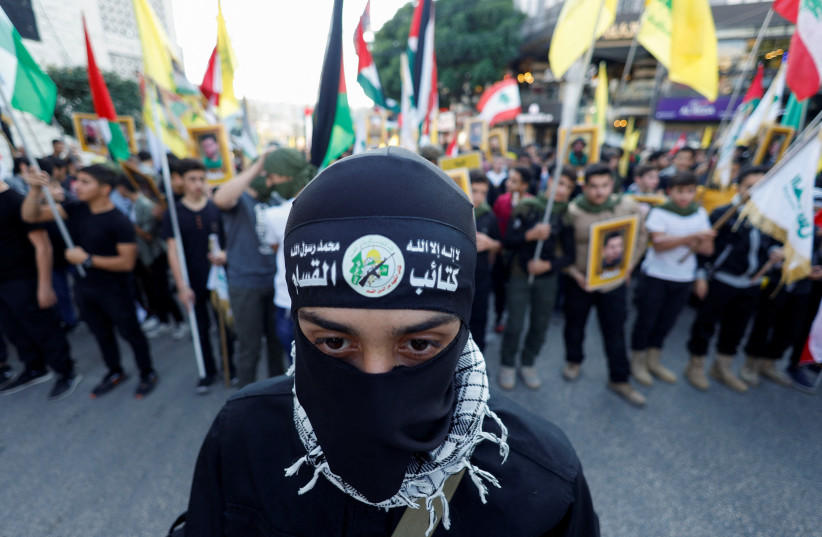Iran has been dictating the tempo of the conflict against Israel for more than a year. It began in the fall of 2022 to heat up threats in the West Bank using Palestinian Islamic Jihad. After seeking to empower this proxy group and fill a vacuum left by the failure of the Palestinian Security forces in Jenin, Iran then turned its attention to other fronts.
Iran’s goal has been to “unify” the fronts or “arenas” against Israel. This means bringing together militias and proxies in numerous places; Gaza, the West Bank, Yemen, Lebanon, Syria, Iraq, and other places. Iran has already been able to key most of these arenas into the conflict against Israel.
For instance, back in 2021, Iran already unveiled the growing threat that Iraqi militias might pose, using drones for instance, and it also empowered groups in Syria beyond Hezbollah. What that means is Iran sought to bring Palestinian threats into Lebanon to bolster Hezbollah and also provide Hezbollah with plausible deniability in attacks. Basically, when rockets were fired over Passover 2023, the narrative would be that “a Palestinian militant group fired rockets.”
Iran put its plan into action after October 7, when Hamas attacked Israel in an unprecedented surprise attack and massacre. Iran brought Hezbollah into the conflict and operationalized the Houthis. It already had the assets in these countries to go to “work” against Israel.
For instance, the Shahed kamikaze drones had already been seen in Yemen, according to a January 2021 article in Newsweek. Precision Guided Munitions were already being moved to Lebanon. “Killer drone” teams were already in Syria since 2018. Iran had already tried to move air defenses into Syria in 2018 in preparation for escalation.

With all the pieces on the board, Iran then moved them into action on October 8. However, the question now is, as we approach 90 days or three months into the war, what is Iran’s next plan.
Iran's next move
Iran has been dictating the tempo of the attacks, as noted above. Iran chose to get the Houthis to try to blockade the Red Sea. The US responded with a new task force to help safeguard the freedom of navigation of the seas. Iran sought to bring Hezbollah into the conflict, and the US sent an aircraft carrier on October 7 to deter Iran and its proxies.
It’s important to note that Israel has sought to focus on Gaza and proportionately respond on the northern border to Hezbollah threats. Nevertheless, Hezbollah has lost some 120 of its fighters since October 8. This is not such a small number for Hezbollah which prides itself in its individual fighters. Unlike Hamas, Hezbollah doesn’t like to waste its recruits. The Houthis, by contrast, have not taken any public losses. Militias in Iraq and Syria are intact.
Iran now has a choice. One of its key IRGC officers in Syria, Razi Mousavi, was killed last week. That was an important loss for Iran, and it has blamed Israel for the killing and vowed revenge. However, on December 31, Iranian media was focused on domestic politics. This means Iran is still considering its next moves.
Nevertheless, the Houthi threats persist. They have continued to try to attack shipping in the Red Sea over the last several days. Pro-Iranian militias in Syria also targeted US forces over the weekend. The Houthis Al-Masirah said the “Iraqi resistance” had targeted the US bases in Syria.
Why did the Houthi media say the Iraqis carried out the attack? It's not clear, but it shows how the pro-Iranian groups in Iraq and Syria coordinate and work together and are basically all the same group.
US defense is having an effect
In the Red Sea, the USS Gravely, a guided-missile destroyer, shot down two anti-ship ballistic missiles on December 30. A ship named the Maersk Hangzhou was also struck by a missile. This is believed to be the 23rd attack on ships since November 19, the US Central Command said in a statement.
The US has also broken new records in downing missiles over the Red Sea, giving their air defenses a workout and testing out how all these defenses work against missiles and drones.
On December 31, the Houthis tried to target the Maersk Hangzhou again. Small boats came within 20 meters of the ship. Armed men, specially assigned to the commercial ship for protection, returned fire against the small boats. US helicopters from the USS Eisenhower, an aircraft carrier, and Gravely responded and sank several small boats. This is the first time the US has apparently sunk Houthi boats.
The Houthis clearly think they have impunity. However, that impunity may be running out. Iran, therefore, has to consider carefully its next moves.
If Israel is transitioning to a new phase in Gaza, with less intense combat, then all eyes will be on what Hezbollah will do next. Hezbollah is Iran’s largest proxy. Hamas, which posed a major threat on October 6, one that was largely misunderstood until the massacre the next day, has now seen many of its battalions defeated in Gaza.
The Iraqi and Syrian militias have many local problems to deal with. PIJ in Jenin has also been facing pressure and raids.
The Houthis have shown that they cannot prevent shipping in the Red Sea. In fact, Maersk had just announced on Friday that it would resume Red Sea shipping. This shows that the Houthis are still making a play for the Red Sea, but the US role is having an effect.
